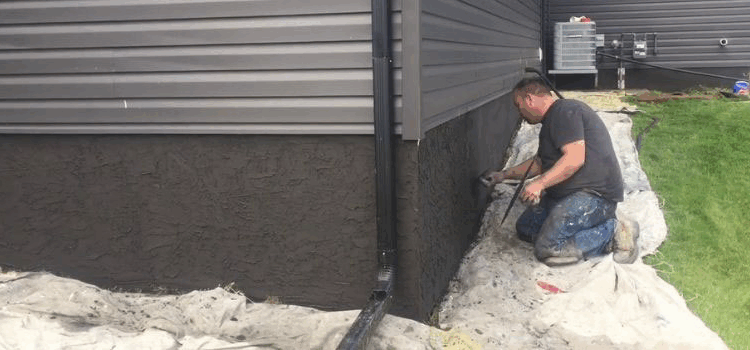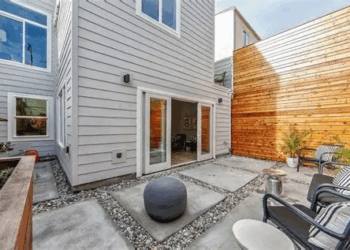
Delving into the world of EIFS siding, this guide aims to provide a detailed overview of this versatile exterior cladding option. From its components to installation process, we will cover everything you need to know about EIFS siding.
Introduction to EIFS Siding
EIFS, which stands for Exterior Insulation and Finish System, is a type of exterior cladding system that provides both insulation and aesthetic appeal to buildings.
Components of EIFS Siding
- Insulation Board: Typically made of expanded polystyrene (EPS), this board is attached to the exterior wall of the building to provide thermal insulation.
- Base Coat: A layer of cement-based material that is applied over the insulation board to provide strength and durability.
- Finish Coat: The final layer of EIFS siding that adds color, texture, and weather resistance to the system.
Benefits of Using EIFS Siding
- Energy Efficiency: EIFS provides excellent thermal insulation, reducing energy costs for heating and cooling.
- Aesthetics: With a wide range of colors and textures available, EIFS can enhance the appearance of a building.
- Moisture Resistance: EIFS is designed to resist moisture, preventing issues such as mold and mildew growth.
- Flexibility: EIFS can be shaped and molded to create unique architectural details on a building’s exterior.
Installation of EIFS Siding
When it comes to installing EIFS siding, there are several important steps to follow to ensure a successful and durable application.
Materials and Tools Required
- EIFS panels or boards
- Moisture barrier
- Base coat and adhesive
- Finish coat
- Reinforcing mesh
- Starter tracks and corner beads
- EPS foam insulation
- EIFS trowels and floats
- Hot knife or saw for cutting
- Notched trowel for adhesive application
Steps for Installation
- Prepare the surface by cleaning and repairing any damage.
- Apply the moisture barrier to prevent water infiltration.
- Install the starter tracks and corner beads to create clean edges.
- Attach the EPS foam insulation panels to the wall.
- Apply the base coat and adhesive to the foam panels.
- Embed reinforcing mesh into the base coat for added strength.
- Apply the finish coat to achieve the desired texture and color.
- Allow the EIFS siding to cure properly before finishing touches.
Special Consideration: Proper installation is crucial for the performance and longevity of EIFS siding. It is recommended to hire experienced professionals for a flawless application.
Maintenance of EIFS Siding
Maintaining EIFS siding is essential to ensure its longevity and appearance. Regular upkeep can prevent costly repairs and keep your home looking pristine. Here are some tips for maintaining EIFS siding effectively.
Cleaning EIFS Siding
- Regularly wash the EIFS siding with a mild detergent and water to remove dirt and grime.
- Avoid using high-pressure washers as they can damage the EIFS finish.
- Inspect the siding for any mold or mildew growth and clean it promptly with a solution of water and bleach.
- Rinse the siding thoroughly after cleaning to prevent residue buildup.
Common Issues and Solutions
- Moisture Intrusion: Check for any cracks or gaps in the EIFS siding and seal them with caulk to prevent water infiltration.
- Staining: Address any stains on the siding promptly by using a mild detergent or specialized cleaner recommended for EIFS.
- Impact Damage: Repair any dents or scratches on the EIFS siding by patching them with a matching finish coat.
- Fading: To maintain the color of the EIFS siding, consider applying a protective coating or paint specifically designed for EIFS surfaces.
Comparison of EIFS Siding with Other Types
When comparing EIFS siding with other types of exterior cladding, it’s important to consider the differences and advantages that each one offers.
EIFS Siding vs. Traditional Stucco
Traditional stucco is a mixture of cement, sand, and water that is applied in multiple layers to create a textured finish. In contrast, EIFS siding consists of a foam board insulation covered with a synthetic stucco-like material. While traditional stucco is durable and fire-resistant, EIFS siding offers better insulation and energy efficiency due to its foam core.
Additionally, EIFS siding is more flexible and can be easily shaped and molded into different designs, offering more versatility in terms of aesthetics.
EIFS Siding vs. Vinyl Siding
Vinyl siding is a popular choice for homeowners due to its low cost and minimal maintenance requirements. However, EIFS siding provides superior insulation properties, helping to reduce energy costs and improve indoor comfort. EIFS siding also offers a wider range of color options and can mimic the look of natural stone or brick more effectively than vinyl siding.
While vinyl siding may be easier to install, EIFS siding provides better protection against moisture and can help prevent mold and mildew growth.
Advantages of EIFS Siding over Other Types of Exterior Cladding
- Superior insulation properties leading to energy efficiency
- More versatile in terms of design and aesthetics
- Effective protection against moisture and mold growth
- Can mimic the look of natural materials like stone or brick
Sustainability and Energy Efficiency of EIFS Siding
EIFS siding is known for its sustainability and energy-efficient properties, making it a popular choice for environmentally conscious building projects.
Environmental Impact of EIFS Siding
- EIFS siding helps reduce energy consumption in buildings by providing insulation that improves energy efficiency.
- It can contribute to lower greenhouse gas emissions by reducing the need for heating and cooling systems.
- EIFS is a lightweight material, which can lead to reduced transportation emissions during delivery compared to heavier building materials.
Energy Efficiency of EIFS Siding
- EIFS siding acts as a continuous insulation barrier, reducing thermal bridging and heat loss in buildings.
- By maintaining a consistent indoor temperature, EIFS can lower energy costs associated with heating and cooling.
- It can help buildings achieve energy efficiency certifications like LEED or Energy Star.
Recyclability of EIFS Siding Materials
- Most components of EIFS siding, such as the foam insulation and base coat, can be recycled.
- Recycling these materials reduces waste in landfills and promotes a more sustainable construction industry.
- Some manufacturers offer take-back programs for used EIFS materials, further supporting the recycling process.
Conclusion
Wrapping up our discussion on EIFS siding, we have explored its benefits, installation process, maintenance tips, and sustainability factors. Hopefully, this guide has shed light on the versatility and efficiency of EIFS siding for your next project.
Key Questions Answered
What are the main components of EIFS siding?
The main components include insulation board, base coat, and finish coat.
How do you effectively clean EIFS siding?
Use a mild detergent and water solution with a soft brush or cloth to gently clean the surface.
What are the advantages of EIFS siding over traditional stucco?
EIFS siding offers better insulation properties and a wider range of design options compared to traditional stucco.
Is EIFS siding recyclable?
Yes, EIFS siding materials are recyclable, making them an environmentally friendly choice.














